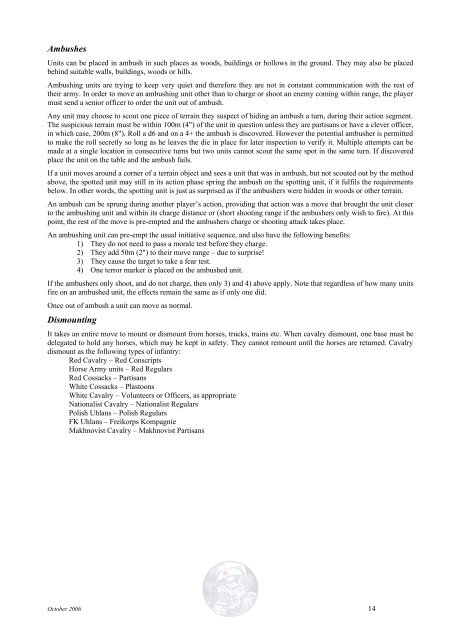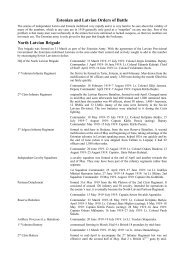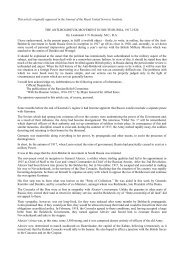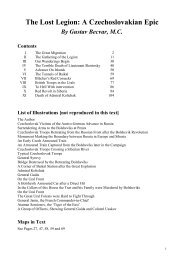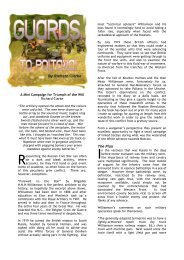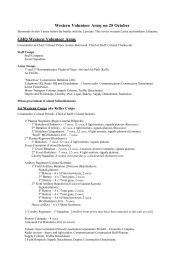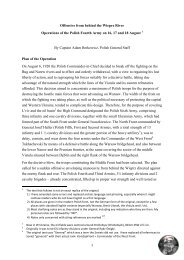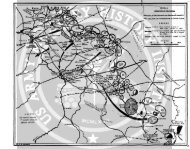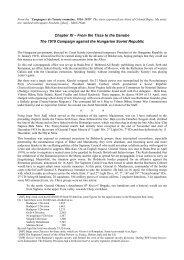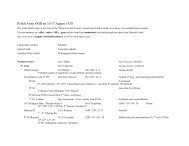You also want an ePaper? Increase the reach of your titles
YUMPU automatically turns print PDFs into web optimized ePapers that Google loves.
Ambushes<br />
Units can be placed in ambush in such places as woods, buildings or hollows in the ground. They may also be placed<br />
behind suitable walls, buildings, woods or hills.<br />
Ambushing units are trying to keep very quiet and therefore they are not in constant communication with the rest of<br />
their army. In order to move an ambushing unit other than to charge or shoot an enemy coming within range, the player<br />
must send a senior officer to order the unit out of ambush.<br />
Any unit may choose to scout one piece of terrain they suspect of hiding an ambush a turn, during their action segment.<br />
The suspicious terrain must be within 100m (4") of the unit in question unless they are partisans or have a clever officer,<br />
in which case, 200m (8"). Roll a d6 and on a 4+ the ambush is discovered. However the potential ambusher is permitted<br />
to make the roll secretly so long as he leaves the die in place for later inspection to verify it. Multiple attempts can be<br />
made at a single location in consecutive turns but two units cannot scout the same spot in the same turn. If discovered<br />
place the unit on the table and the ambush fails.<br />
If a unit moves around a corner of a terrain object and sees a unit that was in ambush, but not scouted out by the method<br />
above, the spotted unit may still in its action phase spring the ambush on the spotting unit, if it fulfils the requirements<br />
below. In other words, the spotting unit is just as surprised as if the ambushers were hidden in woods or other terrain.<br />
An ambush can be sprung during another player’s action, providing that action was a move that brought the unit closer<br />
to the ambushing unit and within its charge distance or (short shooting range if the ambushers only wish to fire). At this<br />
point, the rest of the move is pre-empted and the ambushers charge or shooting attack takes place.<br />
An ambushing unit can pre-empt the usual initiative sequence, and also have the following benefits:<br />
1) They do not need to pass a morale test before they charge.<br />
2) They add 50m (2") to their move range – due to surprise!<br />
3) They cause the target to take a fear test.<br />
4) One terror marker is placed on the ambushed unit.<br />
If the ambushers only shoot, and do not charge, then only 3) and 4) above apply. Note that regardless of how many units<br />
fire on an ambushed unit, the effects remain the same as if only one did.<br />
Once out of ambush a unit can move as normal.<br />
Dismounting<br />
It takes an entire move to mount or dismount from horses, trucks, trains etc. When cavalry dismount, one base must be<br />
delegated to hold any horses, which may be kept in safety. They cannot remount until the horses are returned. Cavalry<br />
dismount as the following types of infantry:<br />
Red Cavalry – Red Conscripts<br />
Horse Army units – Red Regulars<br />
Red Cossacks – Partisans<br />
White Cossacks – Plastoons<br />
White Cavalry – Volunteers or Officers, as appropriate<br />
Nationalist Cavalry – Nationalist Regulars<br />
Polish Uhlans – Polish Regulars<br />
FK Uhlans – Freikorps Kompagnie<br />
Makhnovist Cavalry – Makhnovist Partisans<br />
October 2006 14


